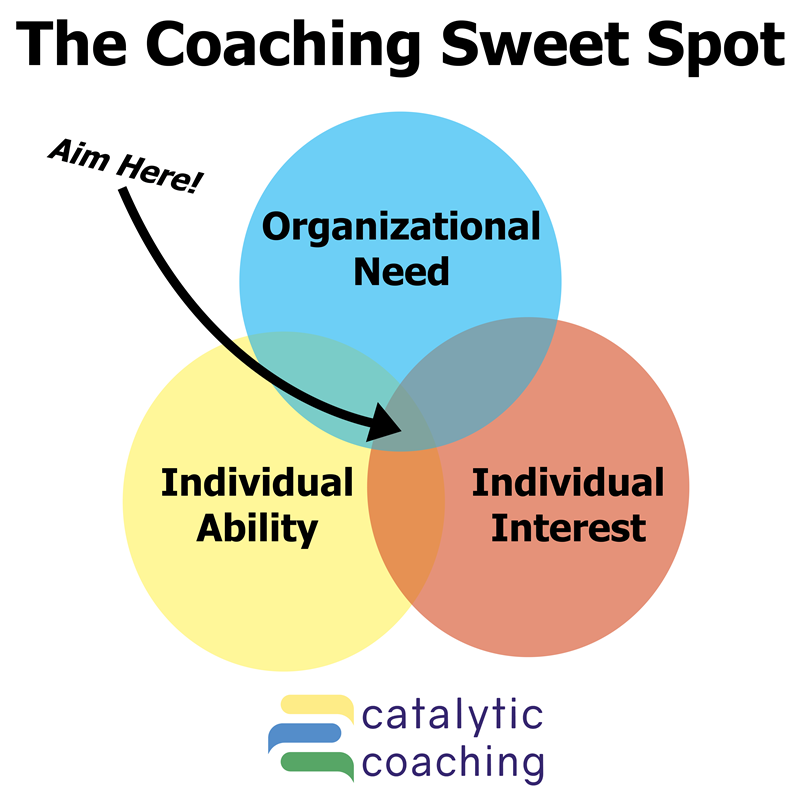Aren’t you tired of hearing about Employee Engagement? Does making employees happy in an economy where jobs are at a premium even matter? No point in adding some pizza parties or flex time to sweeten the deal, right?
Well, employee engagement was never about pizza parties and flex time. All the buzz words and recent bandwagons have watered it down. We’ve lost all sight of what really engages an employee: job satisfaction.
It takes more than a few frills and flashing lights to make a job satisfying for a person. For more than 20 years, Gary Markle has known the secret to tapping into a worker’s true potential and leveraging it for company success: Coaching.
Again, we have another concept that has been woefully watered down. Some of these “new” methods just feel like the old methods rebranded with extra pizzas thrown in. They miss the point and end up with the same lackluster results.
How do you have truly great Coaching?
By finding the Coaching Sweet Spot!
This is where the Individuals Interests and Abilities intersect with the Organizational Needs. That critical juncture that taps your employee’s super powers and puts them to work for mutual benefit. When you identify and cultivate that talent, you have a dedicated worker that is invested in your company’s success. The Catalytic Coaching process gives you all the tools you need to do just that.
Three steps to finding The Coaching Sweet Spot:
Listen first to understand. Leverage that Yellow Employee Input Sheet to get the insight needed to Coach. An employee will reveal how they view themselves and their contributions to the company in the first two sections: Accomplishments and Disappointments. Listen carefully to how they phrase their points and which section is bulked out more. The listening is key. Coaches can ask clarifying questions if they want more details around any examples the employee is giving, but shouldn’t discount or dispute them. Remember these are important enough to their team member to write it down and share.
After those sections, pay attention to what they list “What do I want to be when I grow up.” This tongue-in-cheek approach to opening the future career question is a way that brings levity and opens up the conversation. Here is where you’ll learn where an employee wants to take their career. Are they happy where they are? Are they looking for a management position? Would they rather put their skills to work in another team? Do they want more money or prestige? It’s almost impossible to motivate anyone if you don’t tap into their individual interests.Show us what you can do. Now it’s time for the Blue Coaching Worksheet. The Coaching Sweet Spot comes into play in a couple of ways here.
First, highlight the employee’s abilities in the Strengths section. Taking examples of what they do best and putting them on center stage will let them know they are seen and appreciated. It feels great when hard work is recognized. That kind of satisfaction bonds an employee to their Coach and the company.
Next, take those interests from the Yellow Sheet and the abilities in the Strengths section of the Blue Sheet and combine them with the Organizational Needs. Through the lens of the company’s goals, craft Focus Areas that will leverage an employee’s talents and ambitions. This will be a clear signal that the Coach is listening, they understand their team member, and the worker is more than a worker. They are a whole person that is valued by the organization.Develop those skills. Now they have to work for it. The final step is the Green Development Plan. An employee takes that input from the Blue Sheet and crafts strategic SMART goals to work on throughout the coming year. This makes them a vital part of their own success, giving them ownership of their career and contributions. Regular progress update meetings keep everyone on the same page and ensures that the Coach can correct anyone going off course.
Are your managers struggling to be Coaches? Not sure how to formulate those Focus Areas? Getting lost trying to find the Coaching Sweet Spot?
Sounds like your company could use a trained Coach of Coaches, or, as well call them, a Coach2. These next level Coaches are given in depth training that prepares them to guide managers and support the Catalytic Coaching process.
They’re trained through the Catalytic Coaching Mastery Program, a next-level virtual program that uses interactive exercises and personal attention from Gary Markle and his team. Registration for the session beginning in November 2020 has just opened. Visit the Mastery Program page for more details and to secure your spot.
Garold (Gary) Markle is the creator of Catalytic Coaching and author of Catalytic Coaching: The End of the Performance Review. He brings real world experience from 17 years in HR leadership in major corporations coupled with 20 years of teaching small and mid-sized organizations how to cultivate their leadership and ditch their detrimental performance reviews for a proven Coaching process.
Book Gary to speak to your audience about speeding your pace of significant change.
Connect with him on LinkedIn - Check out his videos on YouTube - Sign up for emails or Request information - Follow on Facebook





